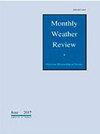Investigating Arctic Cyclone-Tropopause Polar Vortex Interactions with Idealized Observing System Simulation Experiments
IF 2.8
3区 地球科学
Q3 METEOROLOGY & ATMOSPHERIC SCIENCES
引用次数: 0
Abstract
Arctic cyclones (ACs) are a primary driver of surface weather in the Arctic, contributing to heat and moisture transport and forcing short-term sea ice variability. Still, our understanding of the processes that drive ACs, particularly their large scales and long lifetimes, is limited. ACs are commonly associated with one or more cyclonic tropopause polar vortices (TPVs), potential vorticity (PV) anomalies in the upper troposphere and lower stratosphere that may spur baroclinic development in the surface system, though the exact processes that link the two have yet to be fully explored. In this study, we investigate physical links between TPVs, especially their mesoscale structure and moisture profiles, and ACs with idealized observing system simulation experiments (OSSEs). Starting with a nature run, we simulate different types of dropsonde observations over a TPV during the nascent phase of a nearby AC. The Model for Prediction Across Scales (MPAS) and the Data Assimilation Research Testbed (DART) ensemble adjustment Kalman filter are then used to run experiments to test the impact of these detailed TPV observations. In addition to a control, five main experiments are conducted, assimilating new observations of temperature and humidity. All experiments reduce forecast errors at the surface and throughout the troposphere. Additional humidity observations alter vertical PV distributions, which in turn impact the development of the AC. Experiments with additional temperature observations exhibit improvements in TPV structure and surrounding PV features and produce stronger surface cyclones with skillful TPV forecasts for up to 36 hours longer than the control.利用理想化观测系统模拟实验研究北极气旋与对流层顶极地涡旋之间的相互作用
北极气旋(ACs)是北极地表天气的主要驱动力,有助于热量和水分的输送,并影响短期海冰的变化。然而,我们对驱动北极气旋的过程,尤其是对其大尺度和长寿命的了解仍然有限。逆温带通常与一个或多个气旋性对流层顶极地涡旋(TPVs)有关,对流层上部和平流层下部的潜在涡度(PV)异常可能会刺激地表系统的气压发展,但两者之间的确切联系过程仍有待充分探索。在本研究中,我们通过理想化观测系统模拟实验(OSSE)研究了冠状变率(尤其是其中尺度结构和水汽剖面)与气旋之间的物理联系。从自然运行开始,我们模拟了在附近交流的萌芽阶段对冠状病毒进行的不同类型的水滴观测。然后使用跨尺度预报模式(MPAS)和数据同化研究试验台(DART)集合调整卡尔曼滤波器进行实验,以测试这些详细的冠状病毒观测数据的影响。除了对照组之外,还进行了五次主要试验,吸收了新的温度和湿度观测数据。所有实验都减少了地表和整个对流层的预报误差。额外的湿度观测改变了垂直 PV 分布,进而影响了交流的发展。增加温度观测数据的实验显示,热气流结构和周围热气流特征有所改善,产生的地面气旋更强,热气流预报的准确性比对照组提高了 36 小时。
本文章由计算机程序翻译,如有差异,请以英文原文为准。
求助全文
约1分钟内获得全文
求助全文
来源期刊

Monthly Weather Review
地学-气象与大气科学
CiteScore
6.40
自引率
12.50%
发文量
186
审稿时长
3-6 weeks
期刊介绍:
Monthly Weather Review (MWR) (ISSN: 0027-0644; eISSN: 1520-0493) publishes research relevant to the analysis and prediction of observed atmospheric circulations and physics, including technique development, data assimilation, model validation, and relevant case studies. This research includes numerical and data assimilation techniques that apply to the atmosphere and/or ocean environments. MWR also addresses phenomena having seasonal and subseasonal time scales.
文献相关原料
| 公司名称 | 产品信息 | 采购帮参考价格 |
|---|
 求助内容:
求助内容: 应助结果提醒方式:
应助结果提醒方式:


